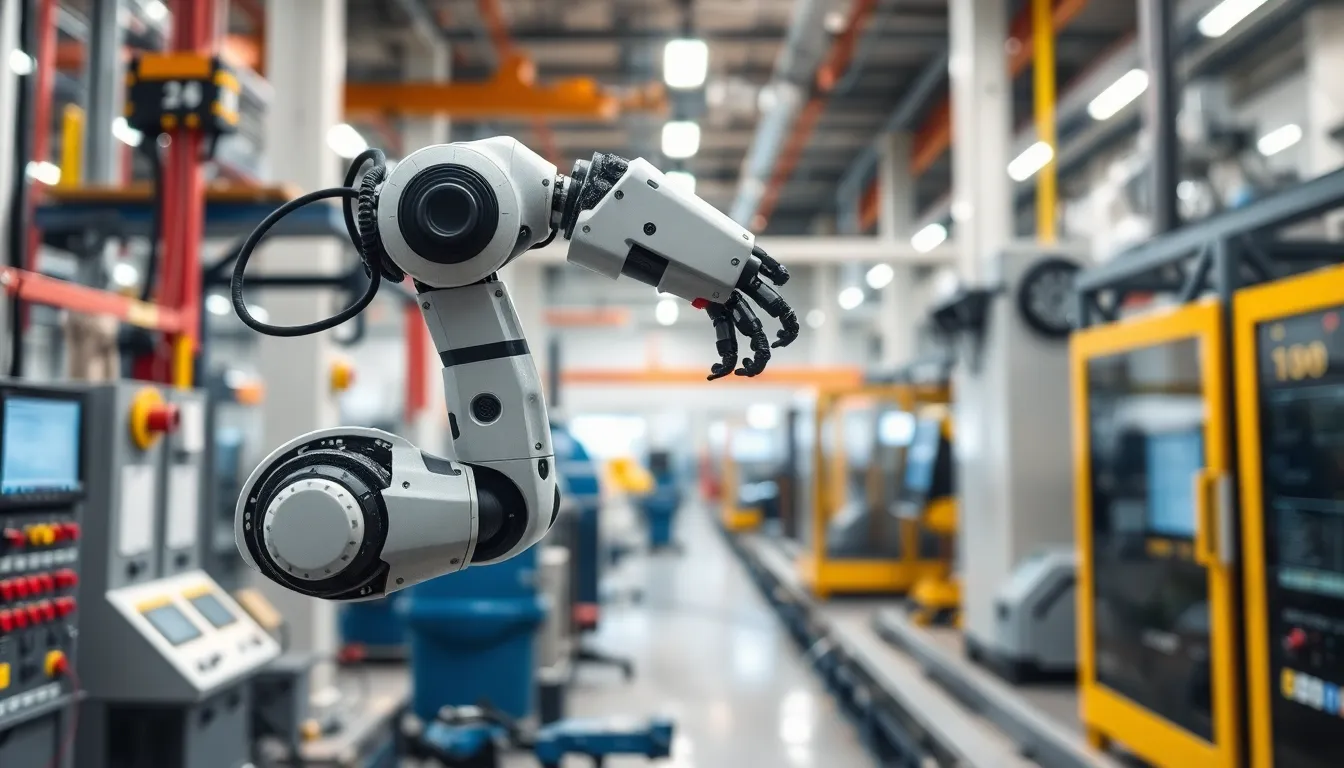Robotics is no longer just a sci-fi fantasy; it’s a reality that’s transforming everyday life. From vacuuming the living room to exploring Mars, robots are stepping up their game and making humans look a little lazy in the process. But hey, who wouldn’t want a mechanical buddy doing the chores while they binge-watch their favorite series?
Table of Contents
ToggleOverview of Technology Innovations in Robotics
Recent developments in robotics highlight a remarkable shift in technology. Companies invest in automation to enhance efficiency across various sectors. Robotics now plays a pivotal role in manufacturing, healthcare, and agriculture. Collaborative robots, known as cobots, work alongside humans, improving productivity and safety.
Advanced sensors enable robots to navigate complex environments. These innovations give machines the ability to perform intricate tasks with precision. The integration of artificial intelligence enhances decision-making capabilities, allowing robots to learn from their experiences. Without traditional programming limitations, they adapt to new challenges effectively.
Robotics also benefits from advancements in materials. Lightweight, durable materials increase flexibility and reduce energy consumption. Innovations in battery technology lead to longer operational times, allowing robots to work autonomously for extended periods. This development improves their utility, particularly in remote or demanding environments.
3D printing revolutionizes the manufacturing of robotic components. This technique facilitates rapid prototyping and customization, giving engineers the ability to design robots tailored for specific tasks. Moreover, the incorporation of machine vision allows robots to interpret and respond to visual data in real-time. These capabilities enable improvements in quality control and precision tasks.
Cloud computing contributes significantly to robotics innovations. It offers resources for data processing and storage, which enhances machine learning applications. By sharing information, robots optimize their performance and collaborate more efficiently. Such connectivity fosters real-time updates and responsiveness in various applications.
As robotics technology continues to evolve, industries witness increased efficiency and new possibilities. The synergy of AI, sensor advancements, and IoT integration shapes the future landscape of robotics, leading to transformative changes in everyday operations.
Major Advancements in Robotics Technology

Robotics technology has experienced significant advancements, transforming various industries and everyday life. Innovations in artificial intelligence and machine learning drive much of this progress.
Artificial Intelligence in Robotics
Artificial intelligence has integrated into robotics, enabling machines to perform complex functions. By using AI, robots can analyze environments and make decisions in real-time. This capability enhances their ability to adapt to unexpected situations, resulting in improved efficiency and safety. For example, AI-driven robotic systems in manufacturing can optimize production lines by predicting equipment failures and minimizing downtime. The combination of AI and robotics supports advancements across sectors, from autonomous vehicles to smart home devices.
Machine Learning Applications
Machine learning applications are shaping the future of robotics. These applications allow robots to learn from data and improve performance over time. In healthcare, for instance, robots utilize machine learning to assist surgeons, becoming more precise with each procedure. Furthermore, agricultural robots analyze soil conditions and crop health, leading to smarter farming practices. Enhanced algorithms enable robots to identify patterns and optimize tasks autonomously. As machine learning continues to evolve, its impact on robotics leads to higher productivity and innovative solutions across diverse industries.
Robotics in Various Industries
Robotics increasingly transforms various industries, enhancing efficiency and productivity. The integration of robots in everyday operations improves outcomes across healthcare, manufacturing, and agriculture.
Healthcare Innovations
Robots play a pivotal role in healthcare by assisting in surgeries and patient care. Surgical robots enhance precision, enabling minimally invasive procedures that reduce recovery time for patients. Automated systems streamline inventory management in hospitals, ensuring critical supplies are always available. Robots equipped with AI assist caregivers by monitoring patient conditions, providing valuable data for decision-making. Telepresence robots facilitate remote consultations, allowing healthcare professionals to see patients from different locations. Innovations in robotic prosthetics also improve patient mobility and quality of life.
Manufacturing and Automation
Automation in manufacturing relies heavily on robotics to boost production capabilities. Collaborative robots, or cobots, work alongside human operators, enhancing safety while performing repetitive tasks. Advanced robotics streamline assembly lines, significantly increasing manufacturing speed. Robots equipped with machine vision perform quality checks in real time, reducing defect rates. Additionally, the use of 3D printing in manufacturing allows for the rapid production of custom parts, further optimizing supply chains. These advancements contribute to a more efficient and flexible manufacturing environment.
Agriculture Enhancements
Robotics revolutionizes agriculture through precision farming techniques. Autonomous drones monitor crop health, providing farmers with real-time data for better decision-making. Specialized robots perform tasks such as planting, weeding, and harvesting, reducing labor costs and increasing efficiency. Automated systems manage irrigation and fertilization based on real-time soil data, optimizing resource use. Robotics also facilitates livestock management, automating feeding and health monitoring. These innovations enable farmers to achieve higher yields while minimizing environmental impact.
Future Trends in Robotics
Robotics technology is poised for rapid evolution, with significant innovations expected in the coming years.
Collaborative Robots (Cobots)
Cobots increasingly assist human workers in tasks, enhancing productivity and safety. These robots are designed to operate alongside people, allowing for seamless interaction in various environments. Companies implement cobots in manufacturing to improve efficiency on assembly lines, fostering a collaborative approach to work. Advanced sensors and intuitive programming empower cobots to adapt to dynamic settings, ensuring a smooth workflow. Many organizations benefit from reduced strain on employees and optimized processes thanks to cobots. The future role of cobots in everyday tasks underscores their importance in shaping the modern workforce.
Autonomous Systems Development
Autonomous systems continue to progress, transforming how industries operate. Robots equipped with advanced AI navigate complex environments independently, significantly improving operational efficiency. Developers focus on enhancing decision-making capabilities, allowing these systems to perform intricate tasks without human intervention. Industries such as logistics and transportation adopt autonomous robots for tasks like warehouse management and delivery. Increased reliability in autonomous systems will lead to wider applications across sectors. As these technologies evolve, they promise to redefine everyday operations, paving the way for smarter workflows and innovative solutions.
Challenges and Considerations
Innovation in robotics brings forth significant challenges and considerations that deserve attention.
Ethical Implications
Ethical concerns arise as robots gain roles in society. The rise of autonomous systems prompts discussions on accountability during decision-making processes. Questions about the implications of replacing human jobs with automation gain prominence, particularly in sectors like manufacturing and healthcare. Many worry about biases in programming and data, impacting fairness in applications such as hiring or legal judgment. Society must navigate these complexities to ensure robots operate in ways that align with human values and ethics.
Security and Privacy Concerns
Security and privacy issues present considerable challenges in the deployment of robotics. As robots become more connected through the Internet of Things (IoT), they face increased risks of cyberattacks. Unauthorized access to sensitive data could lead to breaches in personal privacy, particularly in sectors like healthcare where confidentiality is critical. Protecting user information requires robust cybersecurity measures and compliance with regulations. Addressing these concerns enhances trust and promotes wider adoption of robotic technologies in everyday life.
The advancements in robotics are reshaping various industries and everyday life. As robots become more integrated into daily tasks they enhance efficiency and productivity while allowing humans to focus on more creative pursuits.
Future innovations promise to further transform how we interact with technology. The rise of collaborative robots and autonomous systems will continue to push boundaries in manufacturing healthcare and agriculture.
While the benefits are substantial challenges remain. Addressing ethical concerns security issues and potential job displacement will be crucial as society embraces these technological advancements. The journey of robotics is just beginning and its impact will be felt for generations to come.


